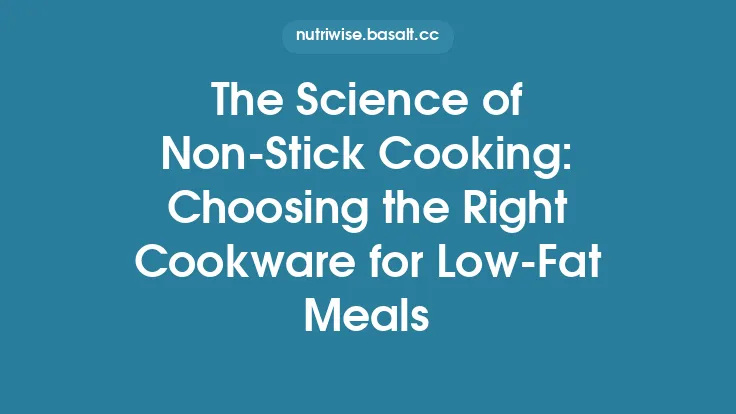Cooking with fats is one of the most nuanced aspects of home and professional kitchens. While the aroma of a hot pan and the sizzle of oil can instantly elevate a dish, the choice of oil determines not only flavor but also how well the fat withstands the temperatures you apply. Selecting the right oil for a given cooking method involves understanding heat stability, oxidative behavior, and the subtle ways in which different fats interact with food. Below is a comprehensive guide that walks you through the science and practicalities of choosing cooking oils, ensuring you get the best performance and nutrition from every drop.
Understanding Heat Stability
Heat stability refers to an oil’s ability to maintain its chemical structure when exposed to high temperatures. When an oil is heated beyond its stable range, its fatty acids begin to break down, forming free radicals, aldehydes, and other compounds that can impart off‑flavors and potentially diminish nutritional value. Two key concepts underpin heat stability:
- Thermal Decomposition – The point at which the oil’s triglyceride molecules start to break apart. This is typically observed as a change in color, a burnt smell, or the formation of visible smoke.
- Oxidative Degradation – Even if an oil does not visibly smoke, exposure to heat and oxygen can cause the double bonds in unsaturated fatty acids to oxidize, producing volatile compounds that affect taste and safety.
Understanding where an oil sits on these two axes helps you match it to the cooking technique you plan to use.
Smoke Point vs. Flash Point: What the Numbers Mean
- Smoke Point – The temperature at which an oil begins to produce a continuous stream of visible smoke. This is the practical ceiling for most cooking methods. Once the smoke point is reached, the oil’s flavor changes, and harmful compounds start to form.
- Flash Point – The temperature at which oil vapors can ignite in the presence of an open flame. This is considerably higher than the smoke point and is more relevant for safety in industrial settings than everyday cooking.
While many resources list smoke points for various oils, it’s important to recognize that these values are not fixed. Factors that shift the smoke point include:
- Refinement Level – Highly refined oils have most of their impurities and free fatty acids removed, raising the smoke point.
- Age and Storage – Oxidized or rancid oils have lower smoke points because degradation products act as nucleation sites for smoke formation.
- Presence of Food Particles – Adding ingredients to hot oil can lower the effective smoke point due to moisture and solids catalyzing breakdown.
When selecting an oil, treat the listed smoke point as a guideline rather than an absolute limit, and always monitor visual cues during cooking.
Oxidative Stability and Fatty Acid Composition
The susceptibility of an oil to oxidation is largely dictated by its fatty acid profile:
| Fatty Acid Type | Typical Saturation | Oxidative Stability | Common Sources |
|---|---|---|---|
| Saturated (e.g., stearic, palmitic) | No double bonds | Very high | Coconut oil, palm kernel oil, butter |
| Monounsaturated (e.g., oleic) | One double bond | Moderate to high | Olive oil, avocado oil, high‑oleic sunflower oil |
| Polyunsaturated (e.g., linoleic, linolenic) | Two or more double bonds | Low to moderate | Sunflower oil, corn oil, soybean oil, grapeseed oil |
- Saturated fats are the most heat‑stable because they lack double bonds that can react with oxygen.
- Monounsaturated fats strike a balance: they tolerate moderate to high heat while still offering a favorable nutritional profile.
- Polyunsaturated fats are prone to rapid oxidation, especially at temperatures above 350 °F (177 °C). They are best reserved for low‑heat applications or cold preparations.
The presence of natural antioxidants (e.g., tocopherols in wheat germ oil) can improve oxidative stability, but these compounds are often diminished during refining. Therefore, a highly refined oil with a high smoke point may still be vulnerable to oxidation if it is rich in polyunsaturated fatty acids.
Choosing Oils for Specific Cooking Techniques
| Cooking Method | Recommended Oil(s) | Reasoning |
|---|---|---|
| Searing / Stir‑Frying (≥ 400 °F / 204 °C) | Refined avocado oil, refined peanut oil, refined high‑oleic sunflower oil, refined coconut oil | High smoke points (≥ 450 °F) and strong oxidative stability. |
| Deep‑Frying (350‑375 °F / 177‑191 °C) | Refined canola oil, refined soybean oil, refined palm oil, refined rice bran oil | Moderate to high smoke points, cost‑effective for large volumes, acceptable flavor neutrality. |
| Sautéing / Pan‑Roasting (300‑350 °F / 149‑177 °C) | Extra‑virgin olive oil (if not exceeding 350 °F), avocado oil, grapeseed oil (use fresh) | Provides flavor while staying within safe temperature range; extra‑virgin olive oil’s antioxidants add a protective layer. |
| Baking (250‑375 °F / 121‑191 °C) | Light olive oil, melted butter, refined coconut oil, walnut oil (for flavor) | Lower temperatures reduce oxidation risk; flavor contributions can be leveraged for specific baked goods. |
| Dressings & Finishing (room temperature) | Cold‑pressed extra‑virgin olive oil, flaxseed oil, walnut oil, sesame oil | Preserve delicate flavors and nutritional compounds; avoid heating to maintain integrity. |
| High‑Heat Grilling (direct flame) | Refined avocado oil, clarified butter (ghee) | Ghee’s low moisture content raises its smoke point; avocado oil tolerates direct flame without rapid breakdown. |
Special Note on Clarified Fats: Removing milk solids from butter (producing ghee) or from animal fats (producing tallow) raises the smoke point dramatically (often > 450 °F). These clarified fats are excellent for high‑heat applications while imparting a subtle, buttery flavor.
Nutrient Retention and Flavor Considerations
While heat stability is paramount, the culinary impact of an oil’s flavor and its retained nutrients cannot be ignored:
- Flavor Transfer: Some oils carry distinct taste profiles—sesame oil adds nuttiness, olive oil contributes fruitiness, and coconut oil imparts a tropical note. Pair the oil’s inherent flavor with the dish’s cuisine to enhance overall harmony.
- Heat‑Sensitive Nutrients: Certain oils contain heat‑sensitive phytochemicals (e.g., polyphenols in extra‑virgin olive oil). If preserving these compounds is a priority, use the oil for low‑heat or finishing applications.
- Fat‑Soluble Vitamins: Vitamin E (tocopherols) is present in many vegetable oils. While some loss occurs with heating, a modest amount remains even after typical sautéing, contributing to the dish’s antioxidant capacity.
Balancing these aspects means you may choose a high‑smoke‑point oil for the cooking phase and finish the dish with a drizzle of a more flavorful, lower‑smoke‑point oil to achieve both performance and taste.
Practical Tips for Storage and Reuse
- Store in Dark, Cool Places: Light and heat accelerate oxidation. Keep oils in amber or opaque containers, preferably in a pantry or refrigerator for oils rich in polyunsaturated fats.
- Seal Tightly: Exposure to air introduces oxygen, which drives rancidity. Use containers with airtight seals.
- Avoid Repeated Heating: Each heating cycle depletes antioxidants and increases free radical formation. If you must reuse oil (e.g., for deep‑frying), filter out food particles, cool it quickly, and store it in the refrigerator for no more than a few days. Discard if it develops off‑odors, darkens, or reaches a lower smoke point.
- Monitor for Smoke: Even with a high smoke point, oil can degrade faster if the pan is overheated. Use a thermometer or visual cues (steady, thin smoke) to stay within safe limits.
- Label Reused Oil: Write the date and the type of food previously fried on the container. This helps you track how many cycles the oil has undergone.
Emerging Technologies and Processing Methods
- High‑Oleic Varieties: Plant breeding has produced high‑oleic versions of traditionally polyunsaturated oils (e.g., high‑oleic sunflower, high‑oleic safflower). These contain up to 80 % monounsaturated fat, offering a higher smoke point and better oxidative stability while retaining a neutral flavor.
- Molecular Distillation: This refining technique removes volatile oxidation products without stripping the oil of all natural antioxidants, resulting in a product that balances a high smoke point with a modest level of health‑promoting compounds.
- Enzyme‑Modified Oils: Certain processes use lipase enzymes to selectively remove undesirable fatty acids, tailoring the oil’s composition for specific culinary uses (e.g., reducing linoleic acid to improve frying stability).
These advances expand the toolbox for cooks who want both performance and nutritional integrity.
Putting It All Together: A Decision Framework
- Identify the Cooking Temperature Range – Determine the maximum temperature your method will reach.
- Match the Smoke Point – Choose an oil whose smoke point comfortably exceeds that temperature, adding a safety margin of 20–30 °F.
- Consider Fatty Acid Profile – For temperatures above 350 °F, favor saturated or monounsaturated oils; reserve polyunsaturated oils for low‑heat or cold uses.
- Factor in Flavor – Decide whether the oil’s taste should be a background note or a starring element.
- Plan for Post‑Cooking – If the dish will be finished with a drizzle or garnish, select a complementary oil for that step.
- Check Storage Logistics – Ensure you have appropriate containers and a storage environment to keep the oil fresh.
By following this framework, you can confidently select the optimal oil for any culinary task, achieving the desired texture, flavor, and nutritional outcome.
Final Thoughts
Cooking with fats is a blend of chemistry, technique, and sensory art. While the science of heat stability provides clear guidelines—favor saturated and monounsaturated fats for high‑heat work, respect smoke points, and guard against oxidation—the culinary world thrives on nuance. The right oil can transform a simple stir‑fry into a dish bursting with depth, or a humble sautéed vegetable into a showcase of subtle aromatics.
Remember that the best oil is the one that meets the temperature demands of your recipe, aligns with the flavor profile you envision, and remains stable enough to preserve its nutritional qualities. With the knowledge outlined above, you now have a robust, evergreen reference to navigate the vast pantry of cooking oils and make informed, confident choices every time you turn on the stove.





